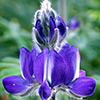Tall annual, up to 120 cm, with deep blue flowers concentrated at the top of the plants. Usually appear in large clusters, but very impressive as a single plant among the small weeds and low bushes. It is easy to identify by its special leaves and unique inflorescence. The large seeds germinate in autumn after the first rains. The large digitate leaves have six to 10 spatulate lobes densely covered by soft white hairs. Rain drops tend to get caught by these hairs and decorate the leaves with shining spots.
The leaves of this species, as those of the other lupine species track the sun movement in the sky. In the morning they are turned Eastward towards the rising sun. And during the day the leaflets turn to face the sun all the time until they face Westward as the sun sets. During the night the leaves turn back to be ready for the rising sun the next morning. When the sky is cloudy and the sun rays do not reach the plants, the leaflets maintain a horizontal position facing upwards. The leaflets movement is enabled by changes in the volume of cells in a special organ called pulvinus at the base of each leaflet. In cases of drought the leaf movement stops and in severe instances the leaflets fold along their central vein. This mechanist of sun-tracking, heliotropism in Greek, is exhibited also by species of mallows, Malva and Lavatera. It was studied by Prof. Dov Koler and his students at The Hebrew University. The hypothesis is that this mechanism increases eh absorption of sunlight by the winter annuals that grow in semi-arid habitats and must take advantage of the short rainy season for fast growth and seed production.
The blue lupines bloom in Israel from February until May. The flowers are concentrated in a dense cluster at the top of the erect branches made of 4 to 8 whorls, 5 flowers in each whorl. The older flowers in the lower whorls open first and the other whorls follow consecutively toward the single flower at the top. The petals color is deep blue, a rare color among flowers in Israel and especially in this family of plants. The flowers have 5 petals that form a sailboat-like structure with a wide spinnaker that has a vertical stripe in the middle. This stripe is white at first and turns red after the flower has been pollinated, supposedly signaling coming bees to go to other flowers. There are rare plants of this species with pink or purple flowers instead of blue.
The evolutionary explanation for this phenomenon is that it maximizes the benefits of insect services to the plant by preventing ineffective visits in flowers that have already been pollinated, directing the insects to the yet un-pollinated flowers.
In this type of boat-like flowers all the anthers are hidden inside the ‘keel’ formed by two petals. When the insect lands o the flower and pushed its way toward its center the pollen is released gradually like the toothpaste from a tube, a small amount for each insect. The flowers do not, have nectar and the insects, especially bees, visit them in order to collect the pollen.
Blue lupines grow in large dense clusters which may be the result of the dispersal of the heavy seeds to short distances. The seed contain large amounts of reserves that ensure success of the seedlings which develop close to one another. The pod is thick and turns from light green to light brown when ripe. It is also covered with dense short soft white hairs. The ripe pods break at the seams and its two parts twist rapidly catapulting the seeds to a distance of about 1 m.
In Israel it appears from the upper Galilee to the Judea Mountains.
Certain lupine species are cultivated and used as fodder or human food. The seeds are boiled several times before served, in order to neutralize the toxins they contain and reduce their bitterness. The lareg seeds are rich in proteins and other nutritious compounds.
There are 200-3030 lupine species in the world most of them in the Americas, from which some species were transferred to other continents and became invasive in Northern Europe and in New-Zealand. In Israel there are 4 more lupine species.
Written by Mike Livneh







